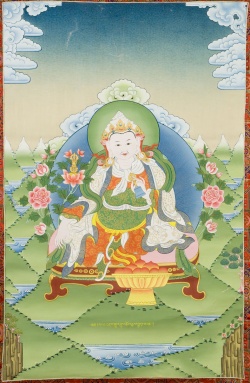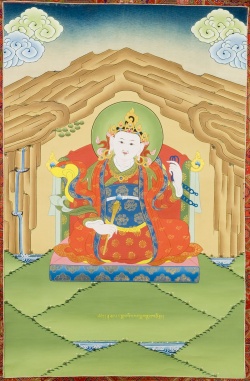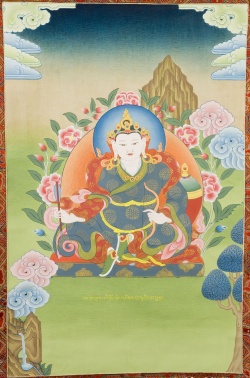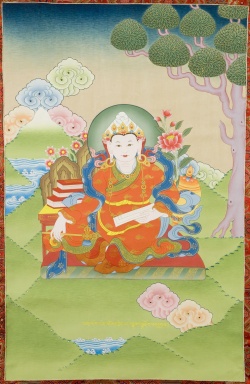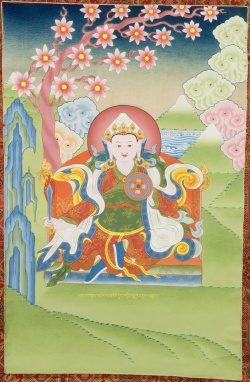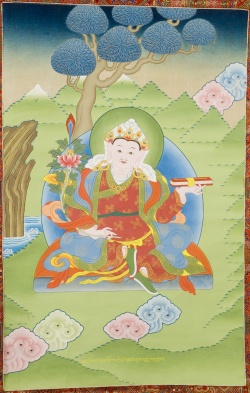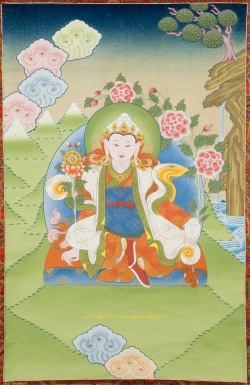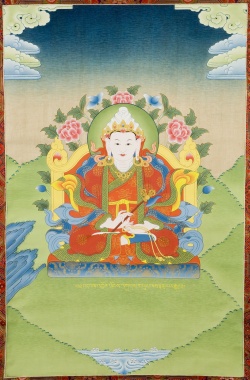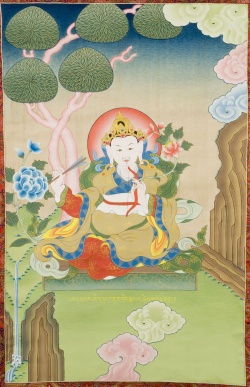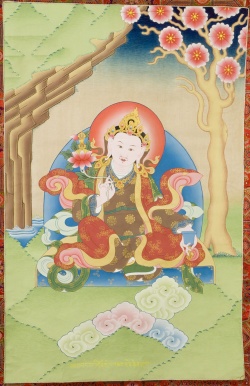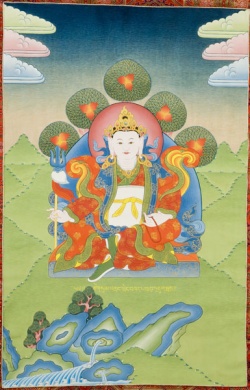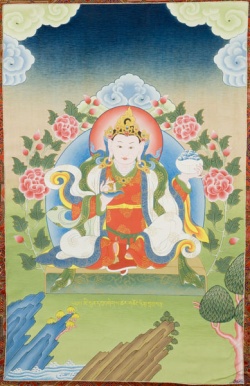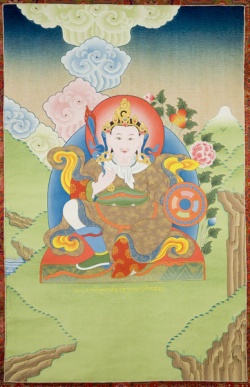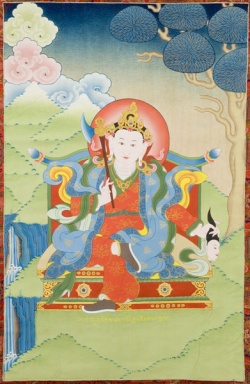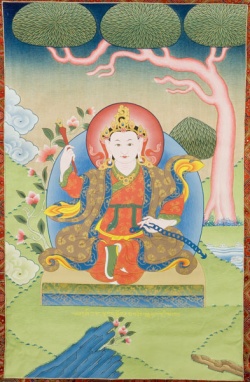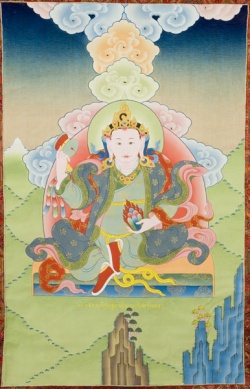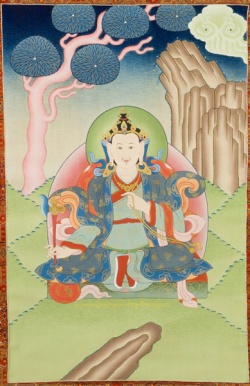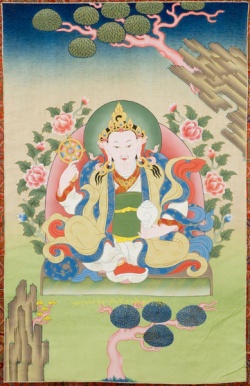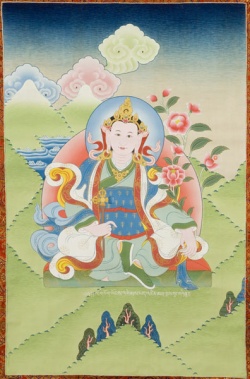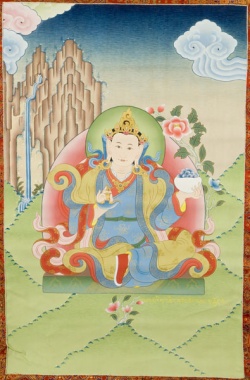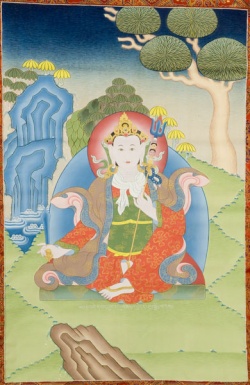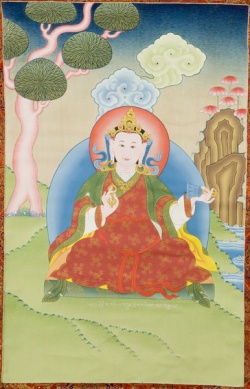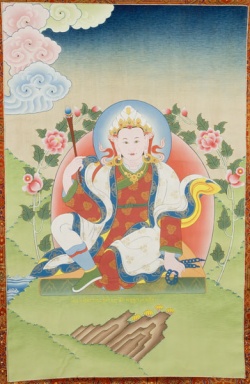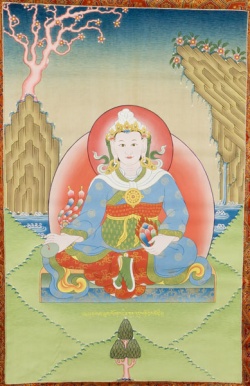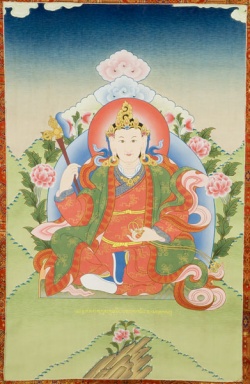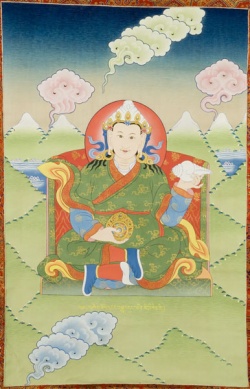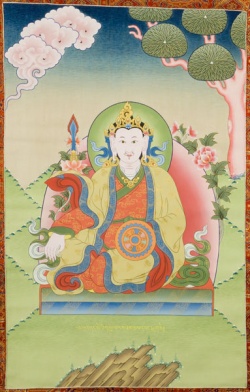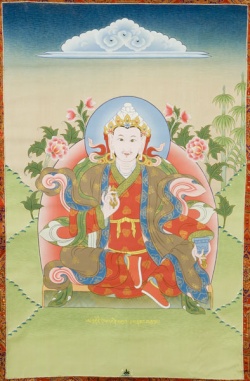Difference between revisions of "The Kings of Sambhala"
m (Text replacement - "]]]" to "]])") |
|||
| (7 intermediate revisions by 3 users not shown) | |||
| Line 1: | Line 1: | ||
| − | === The seven Dharma Kings === | + | === The seven [[Dharma Kings]] === |
| − | Here are depicted the 32 kings of Sambhala from the Tibetan tradition. On this page are the seven [[Dharma]] kings that are said to have preceeded the Kalkī (rigs ldan) kings, who number 25. Please scroll down to see all [[ | + | <noinclude>Here are depicted the 32 {{Wiki|kings}} of [[Sambhala]] from the [[Tibetan tradition]]. On this page are the seven [[Dharma]] {{Wiki|kings}} that are said to have preceeded the [[Kalkī]] ([[rigs ldan]]) {{Wiki|kings}}, who number 25. Please scroll down to see all the [[Dharma]] {{Wiki|kings}}, and click on any of them to see a [[higher]] resolution {{Wiki|image}}. |
| − | The paintings shown here belong to Benchen monastery in Kathmandu, Nepal. They were commissioned for the large Kālacakra [[Empowerment]] given there in 2005 at the time of the Kālacakra revelation by Ven. [[Tenga Rinpoche]]. | + | The paintings shown here belong to [[Benchen monastery]] in {{Wiki|Kathmandu}}, [[Nepal]]. They were commissioned for the large [[Kālacakra]] [[Empowerment]] given there in 2005 at the [[time]] of the [[Kālacakra]] [[revelation]] by Ven. [[Tenga Rinpoche]].</noinclude> |
{| | {| | ||
|- | |- | ||
| − | | [[File:Skd01b.jpg|thumb|250px|1. The first Dharma king of Sambhala, Sucandra (zla ba bzang po), an emanation of Vajrapāṇi, who is said to have received the Kālacakra teachings from the Buddha.]] | + | | [[File:Skd01b.jpg|thumb|250px|1. The first [[Dharma]] [[king]] of [[Sambhala]], [[Sucandra]] ([[zla ba bzang po]]), an [[emanation]] of [[Vajrapāṇi]], who is said to have received the [[Kālacakra]] teachings from the [[Buddha]].]] |
| − | || [[File:Skd02b.jpg|thumb|250px|2. Sureśvara (lha'i dbang po), an emanation of Kṣitigarbha]] | + | || [[File:Skd02b.jpg|thumb|250px|2. [[Sureśvara]] ([[lha'i dbang po]]), an [[emanation]] of [[Kṣitigarbha]])] |
| − | || [[File:Skd03b.jpg|thumb|250px|3. Tejī (gzi brjid can), an emanation of Yamāntaka.]] | + | || [[File:Skd03b.jpg|thumb|250px|3. [[Tejī]] ([[gzi brjid can]]), an [[emanation]] of [[Yamāntaka]].]] |
| − | || [[File:Skd04b.jpg|thumb|250px|4. Somadatta (zla bas byin), an emanation of Nīvaraṇaviṣkambhin.]] | + | || [[File:Skd04b.jpg|thumb|250px|4. [[Somadatta]] ([[zla bas byin]]), an [[emanation]] of [[Nīvaraṇaviṣkambhin]].]] |
| − | || [[File:Skd05b.jpg|thumb|250px|5. Sureśvara (lha'i dbang phyug), an emanation of Jambhaka.]] | + | || [[File:Skd05b.jpg|thumb|250px|5. [[Sureśvara]] ([[lha'i dbang phyug]]), an [[emanation]] of [[Jambhaka]].]] |
|- | |- | ||
| − | | [[File:Skd06b.jpg|thumb|250px|6. Viśvamūrti (sna tshogs gzugs), an emanation of Mānaka.]] | + | | [[File:Skd06b.jpg|thumb|250px|6. [[Viśvamūrti]] ([[sna tshogs gzugs]]), an [[emanation]] of [[Mānaka]].]] |
| − | || [[File:Skd07b.jpg|thumb|250px|7. Sureśāna (lha'i dbang ldan), an emanation of Khagarbha. ]] | + | || [[File:Skd07b.jpg|thumb|250px|7. [[Sureśāna]] ([[lha'i dbang ldan]]), an [[emanation]] of [[Khagarbha]]. ]] |
|} | |} | ||
| − | ==Kalkī Kings== | + | ==[[Kalkī]] [[Kings]]== |
| − | [[File:Sam_mapb.jpg|thumb|250px|A depiction of Sambhala, reputedly painted by, or painted under the direction of, the 8th Karmapa, Mikyo Dorje (mi bskyod rdo rje).]] | + | <noinclude>[[File:Sam_mapb.jpg|thumb|250px|A depiction of [[Sambhala]], reputedly painted by, or painted under the [[direction]] of, the [[8th Karmapa]], [[Mikyo Dorje]] ([[mi bskyod rdo rje]]).]] |
| − | There are some problems with the listing of the kalkī-kings. The general list given in Tibetan texts, and used in the series of pictures shown here, contains 25 names, but the great Indian Kālacakra teacher Vibhūticandra pointed out to Tibetan colleagues that the names of the 18th and 19th in this list, Hari and Vikrama, belonged together as one name, Harivikrama. He also pointed out to them that some Tibetan lists similarly split up the name of number 24 in the list into two names, Ananta and Vijaya. This persists to this day. | + | There are some problems with the listing of the [[kalkī]]-[[kings]]. The general list given in [[Tibetan]] texts, and used in the series of pictures shown here, contains 25 names, but the great [[Indian]] [[Kālacakra]] [[teacher]] [[Vibhūticandra]] pointed out to [[Tibetan]] colleagues that the names of the 18th and 19th in this list, [[Hari]] and [[Vikrama]], belonged together as one [[name]], [[Harivikrama]]. He also pointed out to them that some [[Tibetan]] lists similarly split up the [[name]] of number 24 in the list into two names, [[Ananta]] and [[Vijaya]]. This persists to this day. |
| − | The advice of this great Kālacakra teacher was duly noted by the Tibetans but in practice ignored, and their misreading of the [[Sanskrit]] when translating into Tibetan was not corrected. Accepting his advice would reduce the list to 24 kings, although the predecessor to Cakrī is in fact another by the name of Yaśas, and his inclusion would return the list to the correct count of 25. He is actually mentioned in a quotation from the Kālacakra Mūlatantra, but this has generally been ignored by Tibetan writers. | + | The advice of this great [[Kālacakra]] [[teacher]] was duly noted by the [[Tibetans]] but in practice ignored, and their misreading of the [[Sanskrit]] when translating into [[Tibetan]] was not corrected. Accepting his advice would reduce the list to 24 {{Wiki|kings}}, although the predecessor to [[Cakrī]] is in fact another by the [[name]] of [[Yaśas]], and his inclusion would return the list to the correct count of 25. He is actually mentioned in a quotation from the [[Kālacakra]] [[Mūlatantra]], but this has generally been ignored by [[Tibetan]] writers. |
| − | The additional error of splitting the name of Anantavijaya would produce a list of 26, unless of course the second Yaśas is omitted, which was generally the case in Tibetan lists. | + | The additional error of splitting the [[name]] of [[Anantavijaya]] would produce a list of 26, unless of course the second [[Yaśas]] is omitted, which was generally the case in [[Tibetan]] lists. |
| − | See [[The history of the Kālacakra tradition in Sambhala and India - Based on the writings of Tāranātha|this page]] for the story of how the kings came to be known as kalkī-kings. | + | See [[The history of the Kālacakra tradition in Sambhala and India - Based on the writings of Tāranātha|this page]] for the story of how the {{Wiki|kings}} came to be known as [[kalkī-kings]].</noinclude> |
{| | {| | ||
|- | |- | ||
| − | |[[File:Skk01b.jpg|thumb|250px|1. Yaśas (grags pa(), an emanation of Mañjugoṣa, the king who converted the ṛiṣis to the single vajra-caste. He composed the Laghu-tantra.]] | + | |[[File:Skk01b.jpg|thumb|250px|1. [[Yaśas]] ([[grags pa]](), an [[emanation]] of [[Mañjugoṣa]], the [[king]] who converted the ṛiṣis to the single [[vajra]]-[[caste]]. He composed the [[Laghu-tantra]].]] |
| − | ||[[File:Skk02b.jpg|thumb|250px|2. Puṇḍarīka (padma dkar po(), an emanation of Lokeśvara. He composed the tantra commentary, the Vimalaprabhā.]] | + | ||[[File:Skk02b.jpg|thumb|250px|2. [[Puṇḍarīka]] ([[padma dkar po]](), an [[emanation]] of [[Lokeśvara]]. He composed the [[tantra]] commentary, the [[Vimalaprabhā]].]] |
| − | ||[[File:Skk03b.jpg|thumb|250px|3. Bhadra (bzang po), an emanation of Yamāntaka.]] | + | ||[[File:Skk03b.jpg|thumb|250px|3. [[Bhadra]] ([[bzang po]]), an [[emanation]] of [[Yamāntaka]].]] |
| − | ||[[File:Skk04b.jpg|thumb|250px|4. Vijaya (rnam rgyal), an emanation of Kṣitigarbha.]] | + | ||[[File:Skk04b.jpg|thumb|250px|4. [[Vijaya]] ([[rnam rgyal]]), an [[emanation]] of [[Kṣitigarbha]].]] |
| − | ||[[File:Skk05b.jpg|thumb|250px|5. Sumitra (bshes gnyen bzang po), an emanation of Jambhaka.]] | + | ||[[File:Skk05b.jpg|thumb|250px|5. [[Sumitra]] ([[bshes gnyen bzang po]]), an [[emanation]] of [[Jambhaka]].]] |
|- | |- | ||
| − | ||[[File:Skk06b.jpg|thumb|250px|6. Raktapāṇi (phyag dmar), an emanation of Nīvaraṇaviṣkambhin.]] | + | ||[[File:Skk06b.jpg|thumb|250px|6. [[Raktapāṇi]] ([[phyag dmar]]), an [[emanation]] of [[Nīvaraṇaviṣkambhin]].]] |
| − | ||[[File:Skk07a.jpg|thumb|250px|7. Viṣṇugupta (khyab 'jug sbas pa), an emanation of Mānaka.]] | + | ||[[File:Skk07a.jpg|thumb|250px|7. [[Viṣṇugupta]] ([[khyab 'jug sbas pa]]), an [[emanation]] of [[Mānaka]].]] |
| − | ||[[File:Skk08a.jpg|thumb|250px|8. Arkakīrti (nyi ma grags), an emanation of Khagarbha.]] | + | ||[[File:Skk08a.jpg|thumb|250px|8. [[Arkakīrti]] ([[nyi ma grags]]), an [[emanation]] of [[Khagarbha]].]] |
| − | ||[[File:Skk09a.jpg|thumb|250px|9. Subhadra (shin tu bzang po), an emanation of Vighnāntaka.]] | + | ||[[File:Skk09a.jpg|thumb|250px|9. [[Subhadra]] ([[shin tu bzang po]]), an [[emanation]] of [[Vighnāntaka]].]] |
| − | ||[[File:Skk10a.jpg|thumb|250px|10. Samudravijaya (rgya mtsho rnam rgyal) an emanation of Vajrapāṇi.]] | + | ||[[File:Skk10a.jpg|thumb|250px|10. [[Samudravijaya]] ([[rgya mtsho rnam rgyal]]) an [[emanation]] of [[Vajrapāṇi]].]] |
|- | |- | ||
| − | ||[[File:Skk11a.jpg|thumb|250px|11. Aja (rgyal dka'), an emanation of Yamāntaka. He established the Kālacakra karāna calendar, epoch 806 C.E.]] | + | ||[[File:Skk11a.jpg|thumb|250px|11. [[Aja]] ([[rgyal dka]]'), an [[emanation]] of [[Yamāntaka]]. He established the [[Kālacakra]] [[karāna]] [[calendar]], epoch 806 C.E.]] |
| − | ||[[File:Skk12a.jpg|thumb|250px|12. Sūrya (nyi ma), an emanation of Kiṣitigarbha.]] | + | ||[[File:Skk12a.jpg|thumb|250px|12. [[Sūrya]] ([[nyi ma]]), an [[emanation]] of [[Kiṣitigarbha]].]] |
| − | ||[[File:Skk13a.jpg|thumb|250px|13. Viśvarūpa (sna tshogs gzugs), an emanation of Jambhaka.]] | + | ||[[File:Skk13a.jpg|thumb|250px|13. [[Viśvarūpa]] ([[sna tshogs gzugs]]), an [[emanation]] of [[Jambhaka]].]] |
| − | ||[[File:Skk14a.jpg|thumb|250px|14. Śaśiprabha (zla 'od), an emanation of Nīvaraṇaviṣkambhin.]] | + | ||[[File:Skk14a.jpg|thumb|250px|14. [[Śaśiprabha]] ([[zla 'od]]), an [[emanation]] of [[Nīvaraṇaviṣkambhin]].]] |
| − | ||[[File:Skk15a.jpg|thumb|250px|15. Ananta (mtha' yas), an emanation of Mānaka.]] | + | ||[[File:Skk15a.jpg|thumb|250px|15. [[Ananta]] ([[mtha' yas]]), an [[emanation]] of [[Mānaka]].]] |
|- | |- | ||
| − | ||[[File:Skk16a.jpg|thumb|250px|16. Mahīpāla (sa skyong), an emanation of Khagarbha.]] | + | ||[[File:Skk16a.jpg|thumb|250px|16. [[Mahīpāla]] ([[sa skyong]]), an [[emanation]] of [[Khagarbha]].]] |
| − | ||[[File:Skk17a.jpg|thumb|250px|17. Śrīpāla (dpal skyong), an emanation of Vighnāntaka.]] | + | ||[[File:Skk17a.jpg|thumb|250px|17. [[Śrīpāla]] ([[dpal skyong]]), an [[emanation]] of [[Vighnāntaka]].]] |
| − | ||[[File:Skk18a.jpg|thumb|250px|18. Hari (seng ge), an emanation of Vajrapāṇi.]] | + | ||[[File:Skk18a.jpg|thumb|250px|18. [[Hari]] ([[seng ge]]), an [[emanation]] of [[Vajrapāṇi]].]] |
| − | ||[[File:Skk19a.jpg|thumb|250px|19. Vikrama (rnam par gnon pa), an emanation of Yamāntaka.]] | + | ||[[File:Skk19a.jpg|thumb|250px|19. [[Vikrama]] ([[rnam par gnon pa]]), an [[emanation]] of [[Yamāntaka]].]] |
| − | ||[[File:Skk20a.jpg|thumb|250px|20. Mahābala (stobs po che), an emanation of Kṣitigarbha.]] | + | ||[[File:Skk20a.jpg|thumb|250px|20. [[Mahābala]] ([[stobs po che]]), an [[emanation]] of [[Kṣitigarbha]].]] |
|- | |- | ||
| − | ||[[File:Skk21a.jpg|thumb|250px|21. Aniruddha (ma 'gags pa), an emanation of Jambhaka. The present Kalkī king.]] | + | ||[[File:Skk21a.jpg|thumb|250px|21. [[Aniruddha]] ([[ma 'gags pa]]), an [[emanation]] of [[Jambhaka]]. The present [[Kalkī]] [[king]].]] |
| − | ||[[File:Skk22a.jpg|thumb|250px|22. Narasiṃha (mi'i seng ge), an emanation of Nīvaraṇaviṣkambhin.]] | + | ||[[File:Skk22a.jpg|thumb|250px|22. [[Narasiṃha]] ([[mi'i seng ge]]), an [[emanation]] of [[Nīvaraṇaviṣkambhin]].]] |
| − | ||[[File:Skk23a.jpg|thumb|250px|23. Maheśvara (dbang phyug chen po), an emanation of Khagarbha.]] | + | ||[[File:Skk23a.jpg|thumb|250px|23. [[Maheśvara]] ([[dbang phyug chen po]]), an [[emanation]] of [[Khagarbha]].]] |
| − | ||[[File:Skk24a.jpg|thumb|250px|24. Anantavijaya (mtha' yas rnam rgyal), an emanation of Vajrapāṇi.]] | + | ||[[File:Skk24a.jpg|thumb|250px|24. [[Anantavijaya]] ([[mtha' yas rnam rgyal]]), an [[emanation]] of [[Vajrapāṇi]].]] |
| − | ||[[File:Skk25a.jpg|thumb|250px|25. Rudracakrī (drag po 'khor lo can), an emanation of Mañjuśrī. He is predicted to defeat the barbarians when they finally try to invade Sambhala.]] | + | ||[[File:Skk25a.jpg|thumb|250px|25. [[Rudracakrī]] ([[drag po 'khor lo can]]), an [[emanation]] of [[Mañjuśrī]]. He is predicted to defeat the {{Wiki|barbarians}} when they finally try to invade [[Sambhala]].]] |
|} | |} | ||
| − | + | <noinclude> | |
{{R}} | {{R}} | ||
[http://www.kalacakra.org/kings/skings.htm kalacakra.org] | [http://www.kalacakra.org/kings/skings.htm kalacakra.org] | ||
| − | + | ||
[[Category:Kings of Shambhala]] | [[Category:Kings of Shambhala]] | ||
[[Category:Buddhist Terms]] | [[Category:Buddhist Terms]] | ||
| − | + | </noinclude> | |
Latest revision as of 22:09, 4 April 2016
The seven Dharma Kings
Here are depicted the 32 kings of Sambhala from the Tibetan tradition. On this page are the seven Dharma kings that are said to have preceeded the Kalkī (rigs ldan) kings, who number 25. Please scroll down to see all the Dharma kings, and click on any of them to see a higher resolution image.
The paintings shown here belong to Benchen monastery in Kathmandu, Nepal. They were commissioned for the large Kālacakra Empowerment given there in 2005 at the time of the Kālacakra revelation by Ven. Tenga Rinpoche.
| [[File:Skd02b.jpg|thumb|250px|2. Sureśvara (lha'i dbang po), an emanation of Kṣitigarbha)] | [[File:Skd03b.jpg|thumb|250px|3. Tejī (gzi brjid can), an emanation of Yamāntaka.]] | |||
Kalkī Kings
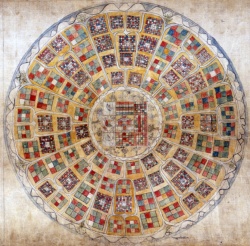
There are some problems with the listing of the kalkī-kings. The general list given in Tibetan texts, and used in the series of pictures shown here, contains 25 names, but the great Indian Kālacakra teacher Vibhūticandra pointed out to Tibetan colleagues that the names of the 18th and 19th in this list, Hari and Vikrama, belonged together as one name, Harivikrama. He also pointed out to them that some Tibetan lists similarly split up the name of number 24 in the list into two names, Ananta and Vijaya. This persists to this day.
The advice of this great Kālacakra teacher was duly noted by the Tibetans but in practice ignored, and their misreading of the Sanskrit when translating into Tibetan was not corrected. Accepting his advice would reduce the list to 24 kings, although the predecessor to Cakrī is in fact another by the name of Yaśas, and his inclusion would return the list to the correct count of 25. He is actually mentioned in a quotation from the Kālacakra Mūlatantra, but this has generally been ignored by Tibetan writers.
The additional error of splitting the name of Anantavijaya would produce a list of 26, unless of course the second Yaśas is omitted, which was generally the case in Tibetan lists.
See this page for the story of how the kings came to be known as kalkī-kings.
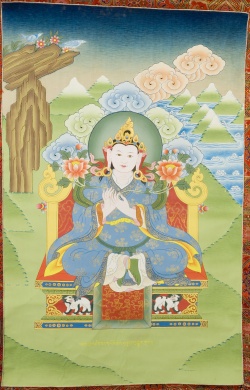 2. Puṇḍarīka (padma dkar po(), an emanation of Lokeśvara. He composed the tantra commentary, the Vimalaprabhā. |
||||
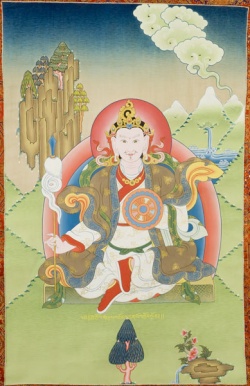 25. Rudracakrī (drag po 'khor lo can), an emanation of Mañjuśrī. He is predicted to defeat the barbarians when they finally try to invade Sambhala. |
